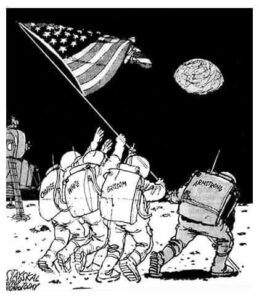Victor Davis Hanson remembers Leo Amery:
A lonely Winston Churchill had only a few courageous partners to oppose the appeasement and incompetence of his conservative colleague Prime Minister Neville Chamberlain. One of the most stalwart truth-tellers was a now little remembered politico and public servant Leo Amery, a polymath and conservative member of Parliament. Yet in two iconic moments of outrage against the Chamberlain government’s temporizing, Amery galvanized Britain and helped end the government’s disastrous policies.
When Germany invaded Poland on September 1, 1939, there was real doubt whether Chamberlain would honor its treaty and declare war on Germany. General Edward Spears, then a member of Parliament, described the scene in the House of Commons. Arthur Greenwood was a member of the Labour Party, Leo Amery was a Conservative.
Arthur Greenwood got up, tall, lanky, his dank, fair hair hanging to either side of his forehead. He swayed a little as he clutched at the box in front of him and gazed through his glasses at Chamberlain sitting opposite him, bolt-upright as usual. There was a moment’s silence, then something very astonishing happened.
Leo Amery, sitting in the corner seat of the third bench below the gangway on the government side, voiced in three words his own pent-up anguish and fury, as well as the repudiation by the whole House of a policy of surrender. Standing up he shouted across to Greenwood: “Speak for England!” It was clear that this great patriot sought at this crucial moment to proclaim that no loyalty had any meaning if it was in conflict with the country’s honour. What in effect he said was: “The Prime Minister has not spoken for Britain, then let the socialists do so. Let the lead go to anyone who will.” That shout was a cry of defiance. It meant that the house and the country would neither surrender nor accept a leader who might be prepared to trifle with the nation’s pledged word.
Greenwood then made a speech which I noted that night as certain to be the greatest of his life; a speech that would illuminate a career and justify a whole existence. It was remarkable neither for eloquence nor for dramatic effect, but the drama was there, we were all living it, we and millions more whose fate depended on the decisions taken in that small Chamber.
Hanson also cites a later speech by Amery, following the loss of the Norway campaign to Germany. Amery responded with a blistering attack on the incompetence of the conservative Chamberlain administration by quoting Oliver Cromwell’s hallmark 1653 order to the Long Parliament:
“You have sat too long here for any good you have been doing. Depart, I say, and let us have done with you. In the name of God, go.”
And go they did, very shortly thereafter, to be replaced by Churchill.
Hanson:
We need a voice like Amery’s. Like Britain from 1939 to 1940, America is in existential danger.
The Biden administration has utterly destroyed the southern border—and immigration law with it.
Biden green lighted 7 million illegal aliens swarming into the U.S. without legal sanction or rudimentary audit.
China spies inside and over the U.S. with impunity. Beijing has never admitted to its responsibility for the gain-of-function Covid virus that killed a million Americans.
President Biden printed $4 trillion at exactly the wrong time of soaring post-COVID consumer demand and supply shortages. No wonder he birthed the worst inflation in 40 years.
In response, interest rates tripled, gas prices doubled.
Our military is thousands of recruits short. It lacks sufficient munitions.
There’s much more–read the whole thing.
Most of what Hanson says is true, and needs to be communicated very clearly to the American people. The question of how this is best done, and how many people are really persuadable, is a difficult one. But that’s not primarily what I want to discuss in this post.
The Hanson post also appears at Zero Hedge. Take a look at the comments–but only if you have a strong stomach–and think about what the opinions expressed there suggest about our current political situation in America.
Discuss.
